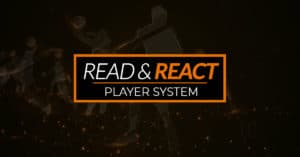Most coaches are control freaks (I am). That’s why we invented plays – so that we can position players exactly where we want them and have them move exactly how we want. The problem is that defenses can play by principle, adjusting quickly to anything the offense does. And, like I said in the previous article, a coach’s predetermined sequence of actions (a play) prevents the offense from being able to adjust to the moment-by-moment actions of the defense.
If that is the case, how do you counter a defense playing by principle? The answer is easy to say, but much harder to do. You must turn your moment-by-moment hunting of scoring opportunities over to your players, while maintaining control of the larger themes of the game (momentum, large adjustments by the defense, etc.). To say it another way: you need to control players and situations through the offense rather than with it.
Consider the following example:
Your team won the previous game with mostly North/South Dribble Penetration and the pitching windows afforded by Circle Movement. It’s only natural that the players think, “So, this is how we win. I can expect these scoring opportunities to be there in the next game.”
Unfortunately, the next team plays defense a little differently and the same opportunities seen in the last game are not there. If the decision is left up to the players, more often than not, they’ll simply try the same action that won the previous game and when it doesn’t work, they’ll try it harder, which leads to more turnovers. Or worse, they’ll begin to play the Blame Game: “It doesn’t work because my teammate is making a bad pass”, or my favorite, “this offense doesn’t work!”
This is where the coach is smarter than the players and must step in to make a change.
In response to your success using North/South Dribble Penetration a smart defensive team could make many adjustments. Below, I’ve outlined four adjustments and how I would handle them from a Read & React perspective. Be sure to notice that the Read & React is never changed. The only change is the emphasis of certain layers or actions based on changes in the defense.
Defensive Adjustment: The defense either reduces its pressure on the ball or is simply a better 1-on-1 defensive team than the previous team. This makes North/South Dribble Penetration difficult.
Offensive Response: Require that Pass & Cut precede any driving action. And, yes, this includes any entries into the Post.
Why would I emphasize Passing & Cutting?
First, guarding a give-and-go is different than guarding someone with the ball who’s trying to dribble penetrate. So, it’s possible that Pass & Cut action could produce scoring opportunities on its own. Looking deeper, though, Pass & Cut forces the defenders to move, change positions, and change stances, which eventually leads to defensive mistakes (an overaggressive close-out, a widened gap). When these mistakes occur, the defense has made itself vulnerable to a variety of other attacks, but mainly Dribble Penetration.
After these concepts are explained and rehearsed in practice, it could be easily called during a game with a phrase like “Pass first, Drive second”, or simply “Pass & Drive“. No need to waste valuable time-outs.
Defensive Adjustment: Double-team the Post.
Offensive Response: We know two things for sure: when there’s smoke, there’s fire and when there’s a double-team, there’s a close-out (or at least, a defensive rotation).
Defensive close-outs are the easiest defensive actions to dribble penetrate against. So, like in the previous example, if Dribble Penetration as the initial action (when the defense is set and in good position) is not as successful against this opponent as it was in the last game, then call, “Post & Drive”. The players should then Pass & Cut or use a Speed Dribble to get the ball into the post before they look to drive and Circle Move.
Defensive Adjustment: The defense sags deep in the lane, focusing on maintaining exaggerated help positions from weak-side defenders. This clogs the lane preventing any Pass & Cut action from making it to the goal and filling all driving lanes with the bodies of weak-side defenders.
Offensive Response: The call is “Pin & Skip First“. This means that regardless of what action is used to get things started, the team is going to hunt for scoring opportunities only after a Pin & Skip. Perhaps “Pin 2” means that the goal for each possession is to get two Pin & Skips into the offensive action as quickly as possible. Of course, we all know that the next defensive action that follows a Pin & Skip is a hard close-out that might even be accompanied by a defensive rotation. We also know that the Pin & Skip creates an inside post-up threat. So, a Pin & Skip is going to force a defensive team to simultaneously guard the perimeter on a hard close-out and to guard inside. That’s pretty difficult.
Defensive Adjustment: The defending team is wary of stepping across the Read Line.
Why would this demand a change of actions by the Read & React offensive players?
Defending inside the Read Line allows the defense to be in better help position against dribble penetration and it makes a give-and-go from our Pass & Cut action less effective.
Offensive Response: To play inside the Read Line the defense must give up pressuring the perimeter pass. This allows the offense to pass freely around the perimeter. So, the weapon of choice should be Multiple Screens.
In order to create this action, the perimeter passing needs to resemble an alternating current. Instead of Pass-Hold-Look, the passing should be Pass-Pass-Hold. This will send two cutters through the lane in quick succession. If the cutters are looking to back screen their way out and if the post (if you’re 4out or 3out) looks to screen for cutters as well, multiple screening opportunities will appear and your offensive action will look different because cutters will be playing off screens. Most importantly, the defense will have to navigate these screens while still closing out short (inside the Read Line).
The defense had prepared for your Driving and Passing action, but must now contend with your Screening action. This verbal call could be, “Alternating Current”. The players understand that this is not a change in the Read & React, but simply a change in emphasis. It’s a change in Hunting Strategy.
Insanity is defined as continuing to do the same thing over and over again expecting to get different results. But many times, that’s what your players will do because they can’t see the big picture like you can. In a perfect world, players could spot these defensive changes and counter accordingly. But, in the meantime (unless your players are perfect), you will have to be the one recognizing what’s going on and making appropriate changes.
So, I’ve given you four offensive counters to four defensive adjustments. Can you think of others? Let us know how you’ve solved similar issues?






